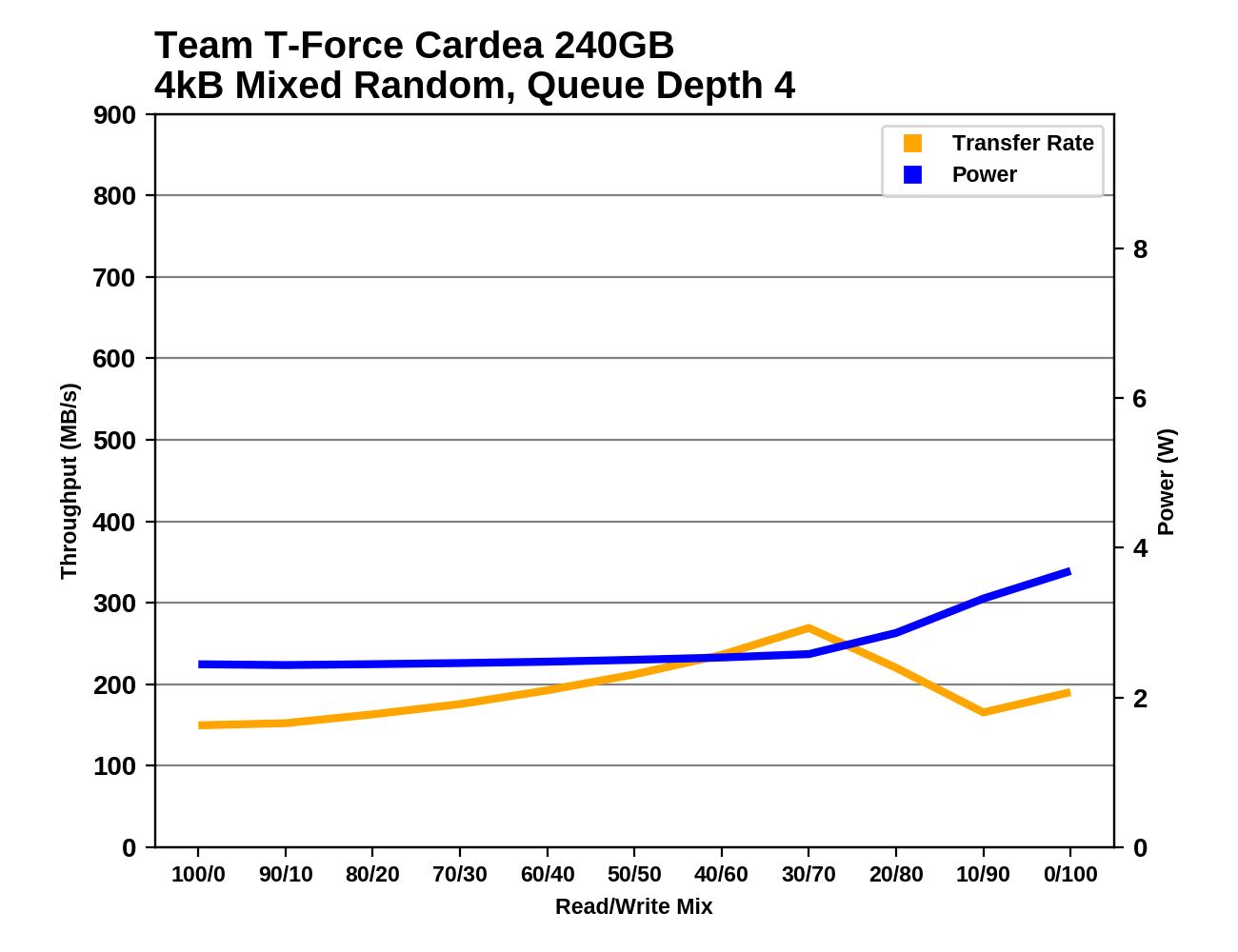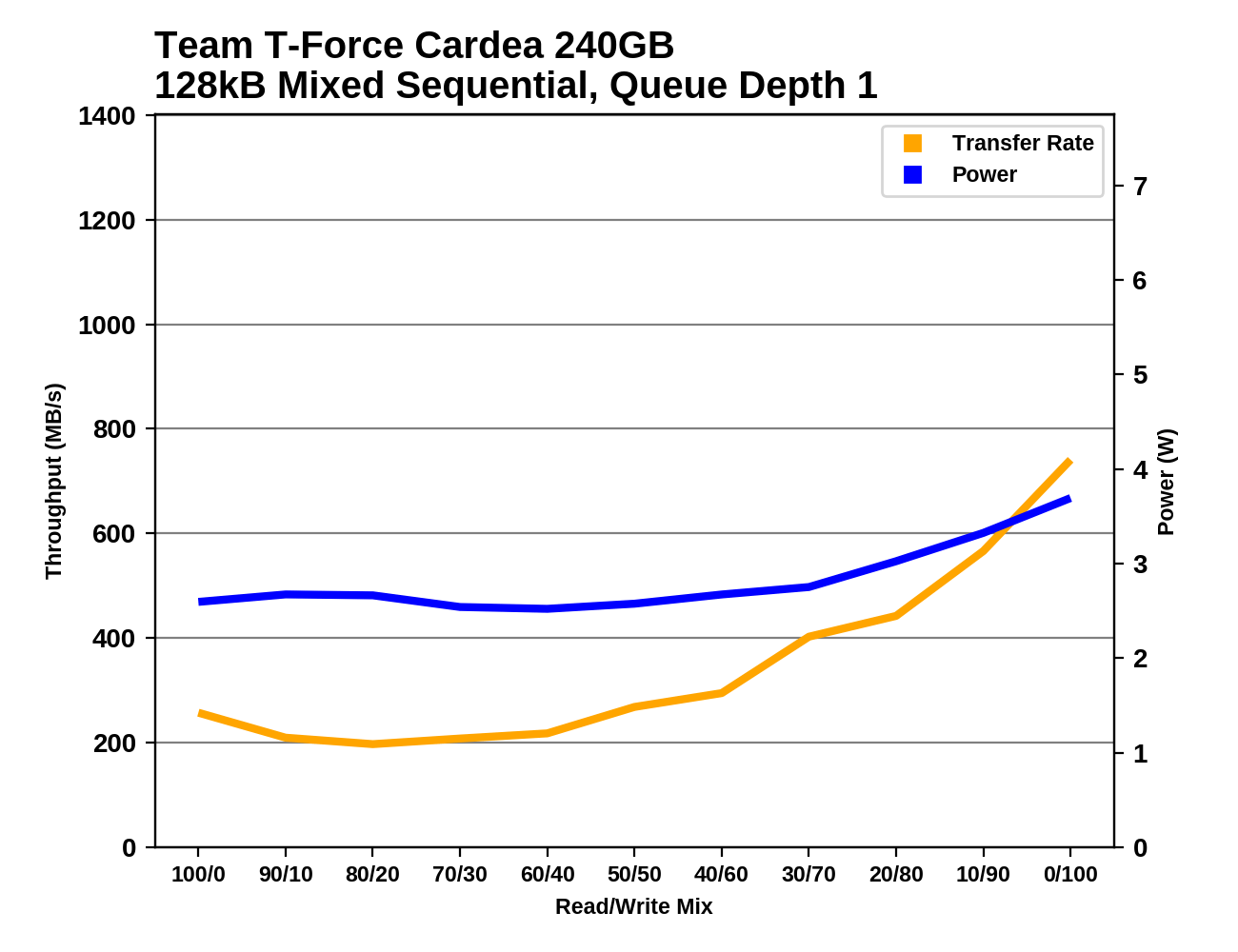The Team Group T-Force Cardea (240GB) SSD Review: Grace Under Write Pressure
by Billy Tallis on September 28, 2017 8:00 AM ESTMixed Random Performance
Our test of mixed random reads and writes covers mixes varying from pure reads to pure writes at 10% increments. Each mix is tested for up to 1 minute or 32GB of data transferred. The test is conducted with a queue depth of 4, and is limited to a 64GB span of the drive. In between each mix, the drive is given idle time of up to one minute so that the overall duty cycle is 50%.

The Team T-Force Cardea has average performance on the mixed random I/O test. It's about the same speed as Samsung's 850 PRO SATA SSD, and is substantially outperformed by some of the larger Phison E7 drives and the Toshiba OCZ RD400. The Samsung 960 EVO does poorly here, with only 75% of the performance overall compared to the T-Force Cardea.

The power efficiency of the T-Force Cardea isn't great; the SATA SSDs that come close to its performance level do so while consuming much less power. While the T-Force Cardea was 32% faster than the Samsung 960 EVO, the Samsung closes the gap a bit on efficiency, leaving the T-Force Cardea with only an 11% efficiency advantage.
 |
|||||||||
The performance of the T-Force Cardea increases slowly across most of the test, until the write volume is high enough to trigger garbage collection. The larger Phison E7 drives never reach that threshold and instead show a spike in performance at the end of the test when the workload is pure writes that can be cached and combined.
The Samsung 960 EVO starts out with slightly higher performance on the random read side of the test, but degrades as the proportion of writes increases through the first half of the test, before increasing at the end and surpassing the T-Force Cardea when it is busy doing background garbage collection.
Mixed Sequential Performance
Our test of mixed sequential reads and writes differs from the mixed random I/O test by performing 128kB sequential accesses rather than 4kB accesses at random locations, and the sequential test is conducted at queue depth 1. The range of mixes tested is the same, and the timing and limits on data transfers are also the same as above.

The top performers on the mixed sequential I/O test are both older NVMe drives: the Samsung 950 PRO and Intel SSD 750. Several of the Phison E7 drives and the Samsung 960 EVO and 850 PRO are all tied for average speed, while the Zotac SONIX and OCZ RD400 are 100MB/s faster.

The Team T-Force Cardea has much better performance per Watt than the other two Phison E7 SSDs that performed the same, and is almost as efficient as the Zotac SONIX that performed much better. Among currently-available NVMe SSDs, the Toshiba OCZ RD400 seems to the best combination of performance and power efficiency on this test.
 |
|||||||||
The T-Force Cardea's performance drops slightly early in the test, but mostly shows increased performance as the proportion of writes increases. There's no sign of the total write volume being enough to force the drive to perform garbage collection outside of the idle periods between sub-tests. The Samsung 960 EVO's performance is almost a mirror of the T-Force Cardea's, with much better performance on the read-heavy half of the test than the write-heavy second half. Samsung's SATA drives are also better on the read-heavy portions. So while several drives are tied for overall average performance, the Samsung drives perform better on the kinds of I/O that consumer workloads are mostly comprised of.










22 Comments
View All Comments
MajGenRelativity - Thursday, September 28, 2017 - link
Yep. Anandtech doesn't have the money to purchase a lot of their own review samples, so it is up to the company to provide them.DanNeely - Thursday, September 28, 2017 - link
More to the point, they can get enough free (donation/loan) hardware to keep their reviewers all busy; why should they buy out of pocket instead. AFAIK most exceptions fall under the category of the reviewer writing about something they bought for personal use.MajGenRelativity - Thursday, September 28, 2017 - link
That also makes senseFlunk - Thursday, September 28, 2017 - link
MyDigitalSSD is a rebrander, they slap their sticker on drives made by an OEM, quite often ADATA. I've taken a look at the model you mentioned and it looks like a PHISON E7 reference design, as such I can't really guess which OEM made it or the real model name.But if you're thinking of buying one, any review of a PHISON E7 reference design should be relevant.
willis936 - Thursday, September 28, 2017 - link
How can anyone compete against samsung in the consumer SSD space?MajGenRelativity - Thursday, September 28, 2017 - link
64 layer NAND and new controllers should allow other companies to do so. The Intel 545s puts up a stiff fightBrokenCrayons - Thursday, September 28, 2017 - link
That's easy, just sell a lower performance product at a competitive price. Certainly Samsung has some good SSDs out there, but the seat-of-the-pants feel between one of their top performing drives and a budget SSD will be small or, in some cases, not noticed outside of benchmarks since the rest of the system becomes a factor in acutal usage. These other competitors can just knock a few percent off the sales price and a lot of people will happily purchase drive that is slower.davidedney123 - Thursday, September 28, 2017 - link
Seriously, who decides "Yeah I'll trust my data to a Team Group Team T-Force Cardea, as it's tuppence cheaper than a drive from Samsung/Intel/Crucial/Some other proper company?Storage is one area I would really not recommend going for off brand tat to save a few dollars.
Billy Tallis - Thursday, September 28, 2017 - link
It's not like any of the important bits are actually designed or built by TeamGroup. This is a Phison drive wearing a Team heatsink. Phison is hardly "off-brand", though they're certainly not the premium brand. They account for a huge portion of the consumer SSD market.davidedney123 - Friday, September 29, 2017 - link
Phison sell them the controller IC, someone else makes the NAND (and the grade will depend on what they are paying the manufacturer for it), but assembly, validation, final testing, and support are all from Frangpai Magic SSD Friend or whatever they are called. My point still stands.